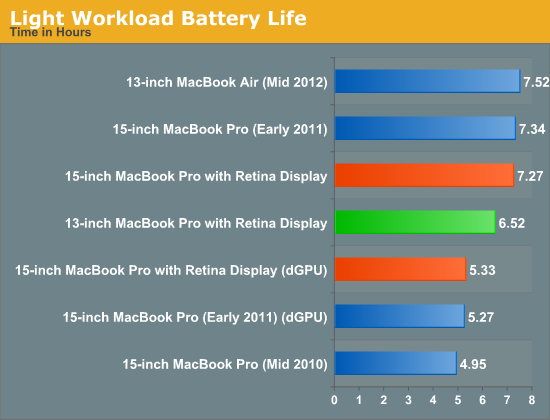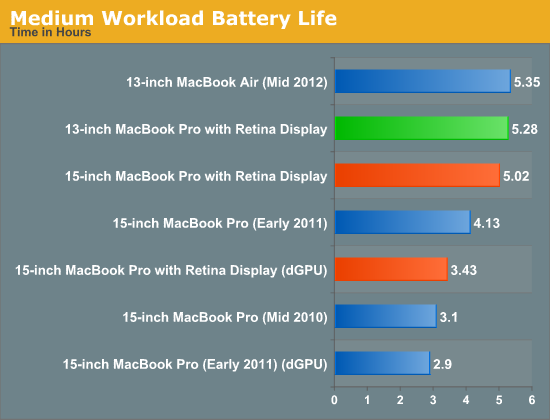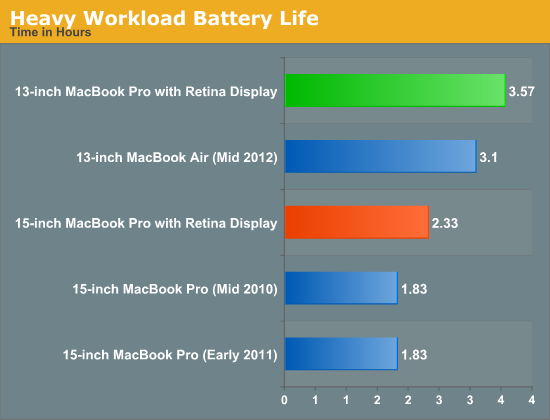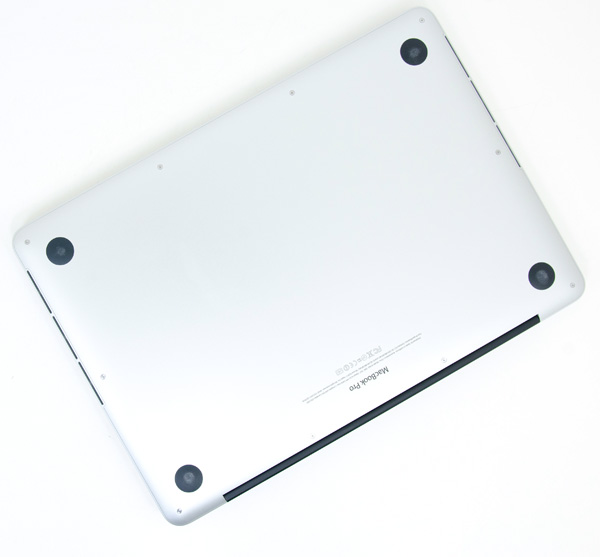13-inch Retina MacBook Pro Review (Late 2012)
by Anand Lal Shimpi on November 13, 2012 2:53 AM ESTBattery Life
The 13-inch rMBP features an integrated 74Wh, non-user-serviceable lithium polymer battery. The smaller chassis forced the use of a smaller battery compared to the 95Wh part used in the 15-inch rMBP. With a 22% reduction in battery capacity, the question is whether or not the drop in power consumption will keep battery life balanced between the two systems. CPU TDPs also go down by an identical 22% (45W down to 35W), but the comparison is more complex than that. The 15-inch rMBP has an on-board discrete GPU that, when active, can significantly impact battery life. Without the dGPU inside the system, the 13-inch rMBP does potentially have an advantage.
To quantify battery life, I turned to our updated OS X battery life suite that I introduced earlier this year. As always we have three individual tests, each simulating a different amount of load. All battery life tests were run with the display calibrated to 200 nits. The test descriptions are below:
The light and medium suites are inherently related - they use the same workload and simply vary the aggressiveness of that workload. The light test hits four different websites every minute, pausing for nearly the entire time to simulate reading time. Flash is enabled and present on three of the sites. The long pause time between page loads is what really makes this a light test. Web browsing may be the medium for the test but if all you're doing is typing, watching Twitter update and maybe lazily doing some other content consumption this is a good representation of the battery life you'll see. It's a great way of estimating battery life if you're going to be using your notebook as a glorified typewriter (likely a conservative estimate for that usage model).
The medium test hits the same webpages (Flash and all) but far more aggressively. Here there's less than 10 seconds of reading time before going onto the next page. It sounds like a small change but the impact on battery life is tremendous.
Both the light and medium tests are run in their default state with processor graphics enabled, as well as with the discrete GPU forced on. I run with the dGPU on as well because it's far too often that a single application open in the background will fire up the dGPU and contribute to draining your battery. The goal here is to deliver useful numbers after all.
The final test is very similar to our old heavy multitasking battery life tests, but with some updates. Here I'm downloading large files at a constant 1MB/s from a dedicated server, while playing back a looped 1080p H.264 movie (the Skyfall trailer) all while running the medium battery life test. The end result is a workload that gives you a good idea of what a heavy multitasking usage model will do in terms of battery life. I've found that OS X tends to fire up the dGPU anyway while running this workload so I saw no reason to run a separate set of numbers for processor and discrete graphics.

Our light workload doesn't do much to stress all four cores in the 15-inch rMBP, so that machine effectively behaves like a 13-inch rMBP with a bigger battery. The larger display (more pixels, more power hungry backlight) does consume a bit more power but the 15-inch rMBP manages to last 11% longer on a single charge compared to the 13-inch model. Turn the dGPU on however and the 13-inch rMBP easily outlasts its bigger brother.
Compare the 13-inch rMBP to the 13-inch MacBook Air and you see exactly why the Air isn't getting a Retina Display anytime soon. With only a 50Wh battery, the MacBook Air manages 15% better battery life than the 74Wh 13-inch rMBP. The MBA uses a much lower powered CPU, but I don't know how responsible that is for the difference in battery life here given the very light workload. If I had to guess, I'd say the reason for the difference here is the display and backlight power consumption. What may be more likely than a MacBook Air with Retina Display is some sort of MBA/Retina iPad convergence into some sort of a new device down the road.

Ratchet up the workload and the two rMBPs look very similar in battery life, with the 13-inch model holding onto a 5% advantage. The 13-inch MacBook Air also loses its battery life advantage here as well. Once again if you turn on the dGPU, the 15-inch rMBP blows through its battery much quicker.

In our heavy test the 13-inch rMBP sets a new record for our new suite, outlasting the 13-inch MBA by 15% (despite having a 48% larger battery). Worst case battery life is much better on the smaller rMBP compared to the 15-inch model thanks to its use of a dual-core processor with no discrete GPU. Performance obviously suffers, but if all you care about is battery life the 13-inch rMBP will do better on a single charge.











79 Comments
View All Comments
repoman27 - Tuesday, November 13, 2012 - link
And just to further clarify, Thunderbolt does not really mux DP and PCIe signals, it takes the packets from both protocols and transports them via a common switching fabric, so that wording is slightly misleading.tipoo - Tuesday, November 13, 2012 - link
In my time with these, I find there is just a bit of UI lag to most things compared to an Air or the regular Macbook Pros, most of the time it's hard to even notice unless they are side by side. The calender flip animation and sometimes the green button re-size are particularly painful, you can literally count out the frames on the former. On the 15" you can force it to use the dGPU on AC power which fixes that, but there is no fallback for the 13".tipoo - Tuesday, November 13, 2012 - link
Speaking of which, if switching to the dGPU fixes some of the lag does that mean more of the rendering pipeline is given to the Nvidia chip unlike the HD4000, as otherwise that would put a hole in the single threaded performance theory?sputnik78 - Tuesday, November 13, 2012 - link
"There's not much you can do here other than wait for faster hardware or buy the fastest CPU available on whatever system you're considering. "Yes there is. Use Firefox or Chrome.
I could not believe the depth of detail in the investigation of the scrolling in Safari issue without the simple test to swap out with Firefox or Chrome and see how much of the problem is Safari rather than the OS/Hardware.
With Firefox, you can enable and disable GPU accelerated UI as well, to see if that helps or hurts.
My experience with all three browsers is that each can have various performance issues with some websites and situations, but that when one does, one of the others tends to be OK.
MrCromulent - Tuesday, November 13, 2012 - link
Firefox doesn't even have Retina support yet, does it? Last time I heard it was planned for version 18.Disabling hardware acceleration in Firefox would probably just result in even worse performance since it is enabled by default and the CPU single-thread performance is going to get even more maxed out otherwise.
paravorheim - Tuesday, November 13, 2012 - link
Dear Anand,you mentioned in both the Intel S3700 and 13" rMBP reviews that OS X did not respond well to high IO latency. Could you expand on what you meant by that? Or is the explanation too complicated to put into layman's terms?
AmdInside - Tuesday, November 13, 2012 - link
I don't see how this is a much better option for someone who travels a lot and uses it mainly for typing. I love my MBA and only wish would be that it had more RAM and IPS display. If i had to do it all over again, I think I would still buy the MBA over the rMBP. If I had more money than I knew what to do with, I guess I'd go with the rMBP though.thefizzle656 - Tuesday, November 13, 2012 - link
IMO what is wrong with the 13" rMBP is not just that the word "Pro" doesn't at all describe the hardware specs and capabilities of the machine, but that it is so so overpriced for what you get. Even Apple Fanbois are have been criticizing Apple for the complete ripoff that the 13" rMBP is.spronkey - Tuesday, November 13, 2012 - link
You know, I have to agree with those who say there's a bit of Apple bias going on here. So many important criteria here have been glossed over - remember the pricing of this machine puts it far out of reach for most 'consumers', who go and buy $500-700 dell machines. It's a high-end part for a high-end prosumer/professional.The bottom line is - 8GB of RAM as a maximum ceiling (note - my *2008* MacBook Pro had the same limit) is far too low, and Anand you of all people should know that in the usable life of this machine (lets say 3 years), that limit is going to be hit - especially when it's not uncommon for web browsers with media-heavy content to eat 2+GB. And the move to 64-bit for stuff like the Adobe creative suite, which is a common use case for this particular machine, will eat even more RAM. I'm running 8GB on my MBP at the moment and I max it out very frequently.
I'm also not sure how you can recommend this over the 13" Air. It's much more expensive, the hardware is largley similar, performance isn't *that* much better, it doesn't offer anything in terms of upgradability other than Thunderbolt connectivity, and it's bigger and heavier. Not to mention in the real world, in 2012, it's a laggier experience.
Now, lets imagine an alternate universe where Apple decided not to shave quite so much off the size of the previous 13" pro, and instead gave us a quad core i5/i7 and a couple of RAM slots. Perhaps even a dedicated GPU and a 2.5" bay. Now that would be an improvement. What we have here is an expensive Macbook Air with a pretty display for text, that makes almost everything else look awful.
seapeople - Saturday, November 17, 2012 - link
When will we stop the insanity with this complaint about memory. Times are different, memory requirements are not going to quadruple again in the next four years. The world is not gearing up for Microsoft Gargantuan 9 which will require 8GB of RAM to load the desktop. If anything the world is going more mobile, and memory requirements will likely stagnate. Consider than an Ipad has just one GB of RAM, and they are selling about as many of those as casual consumer PC's nowadays, and you can see where we're heading.Furthermore, any browser worth its salt that's pushing 2GB of RAM based on some standard media heavy tasks will drop that RAM in an instant without a huge user experience impact if you start nearing a system limit. It's just caching everything in sight because it sees that you have 16 GB of RAM; it doesn't mean your system would grind to a halt with only 8!